Adrian Collins's Blog, page 95
May 31, 2023
REVIEW: The Bone Ships by R.J. Baker
As winner of the 2020 British Fantasy award, The Bone Ships charts the course as captain of modern-day seafaring warfare. This first installment of the Tide Child trilogy starts within an endless war, fought with boneships built from ancient dragons. Rumors of dragon sightings whirl the nations of the Hundred Isles into turmoil. A new dragon hunt begins. R.J. Baker makes waves with his richly detailed world in The Bone Ships.
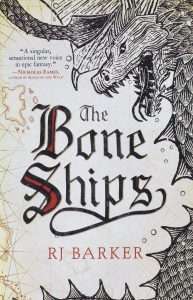 The Bone Ships is told from the perspective of Joron Twiner. As shipwife to a black ship, Joron’s fate is the exact same as his criminal crew-death. Sentenced to serve on a black ship where every mission is suicide, his only hope to earn his life back is to accomplish a truly grand heroic act. An act such as capturing the first sighted live dragon, an arakeesian, in centuries.
The Bone Ships is told from the perspective of Joron Twiner. As shipwife to a black ship, Joron’s fate is the exact same as his criminal crew-death. Sentenced to serve on a black ship where every mission is suicide, his only hope to earn his life back is to accomplish a truly grand heroic act. An act such as capturing the first sighted live dragon, an arakeesian, in centuries.
New boneships cannot be built without the bones of an arakeesian. With only recycled parts available, the number of boneships are dwindling and becoming smaller. These boneships turn the tide of battle. They are paramount for the coming war. All will hunt the last live arakeesian.
Joron’s enemies number greatly between rivaling Guant Islands to other black ships. Fearsome monsters of the deep are all too known for attacking ships. However, his deadliest foe is aboard his ship. The people of Hundred Isles see the world through anger. Life on rock and sand is difficult, even worse is life on the sea. The crew of the Tide Child are ruthless and have scheming minds. Shipwife in name only, Joron’s command lacks respect among his hardened crew.
While danger is consistently lurking, The Bone Ships features rich worldbuilding. I loved discovering the horrors of the corpselights and the awful beakwyrm creatures. Life aboard a ship is especially emphasized. From learning the drills of spinning and loading the bows, and the superstitions surrounding the windtalkers, the first half of The Bone Ships ensures the reader will learn fleet life.
One character is the embodiment of fleet, as if born to the sea. Lucky Meas Gilbryn steals the page with her seafaring knowledge and attitude. While we are not privy to her point of view, understanding her through Joron’s perspective is like watching a legend begin.
She was a storm, a fury, like the Mother had come among them to wreck her havoc and demand her justice.
Joron Twiner embarks on a nautical journey for the ages. By cannon fire or sea dragon, his ship sails towards death. The Bone Ships answers the call for any reader seeking fantasy seafaring adventure.
Read The Bone Ships by R.J. BakerThe post REVIEW: The Bone Ships by R.J. Baker appeared first on Grimdark Magazine.
REVIEW: Buzzard’s Bowl by John Palladino
John Palladino takes his craft to new heights in Buzzard’s Bowl, the second volume of his grimdark fantasy series, The Tragedy of Cedain. I am delighted to see how Palladino has grown as a writer since publishing his first novel, The Trials of Ashmount. Palladino already showed great promise with his debut, and he has made all the right moves with Buzzard’s Bowl.
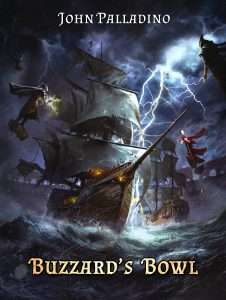 As with The Trials of Ashmount, Buzzard’s Bowl is told as a third-person narrative from the perspectives of five main protagonists. Palladino has improved upon his already strong character development skills, building layers of complexity and strong emotional connections to each of the lead protagonists. Palladino cites Joe Abercrombie as a key influence, and I can definitely see that inspiration in his outstanding character work. The protagonists of Buzzard’s Bowl are all profoundly broken in different ways; yet each of them is sympathetic and relatable.
As with The Trials of Ashmount, Buzzard’s Bowl is told as a third-person narrative from the perspectives of five main protagonists. Palladino has improved upon his already strong character development skills, building layers of complexity and strong emotional connections to each of the lead protagonists. Palladino cites Joe Abercrombie as a key influence, and I can definitely see that inspiration in his outstanding character work. The protagonists of Buzzard’s Bowl are all profoundly broken in different ways; yet each of them is sympathetic and relatable.
First up is Edelbrock Brendis, formerly a minor nobleman who, through his own strategic missteps, finds himself as an enslaved gladiator fighting in the Buzzard’s Bowl arena. Edelbrock is a deeply pathetic and tragic figure, drawing equal parts sympathy and repugnance. Edelbrock grows a lot throughout Buzzard’s Bowl while oscillating between depth and shallowness of character.
My favorite protagonist from The Trials of Ashmount, Demri Slarn, returns in Buzzard’s Bowl with even more emotional baggage than in the first book. Demri is clearly inspired by Sand dan Glokta, Joe Abercrombie’s greatest creation first introduced in The Blade Itself. Like Glokta, Demri is simultaneously a despicable and sympathetic character who experiences tremendous emotional and physical suffering. Like Edelbrock, Demri occupies the full spectrum of gray morality, keeping the reader guessing as to his intentions and actions.
Next is Sera Wintlock, a bird-farming girl who rises to heroism as her family and village are slaughtered. In my previous review of The Trials of Ashmount, I noted the lack of a strong emotional connection with Sera, despite the tragic situations that she endures. This is no longer an issue in Buzzard’s Bowl, as Sera experiences one of the best character arcs in the book, growing as a leader while the emotional trauma from her past finally catches up with her.
Another character who fell strangely flat for me in The Trials of Ashmount was Villic the Imbuer, a nomadic warrior from the Camel Clans who is haunted by a mysterious voice in his mind which he calls Speaker. Villic is a revelation in Buzzard’s Bowl. His inner monologue with Speaker is by turns hilarious and tragic. The suffering that Villic endures in Buzzard’s Bowl and his ensuing character growth make him one of the most endearing characters in this second volume of the series.
Palladino also introduces a new point-of-view character with Ashen, a former street urchin who masquerades as Lady Hyrel to gain access to the inner circle of a particularly despicable noble. I was immediately drawn to Ashen’s character from the moment she was introduced. She reminds me of Vin from Brandon Sanderson’s Mistborn, but with a more grimdark storyline.
Buzzard’s Bowl is fast-paced and full of surprises for each of the main characters, especially when their storylines converge. Palladino shines in writing pulse-pounding action sequences. My favorite is the scene captured on the outstanding cover designed by Dusan Markovic, which depicts a flooded Buzzard’s Bowl arena with battling gladiator ships electrified by levitating Magicai wizards. This is one of several epic action sequences in the book.
Although I’ve already mentioned Joe Abercrombie, I’d argue that George R.R. Martin has an even greater influence on Buzzard’s Bowl. Like the first three volumes of Martin’s A Song of Ice and Fire, Palladino manages a sprawling scope and depth of worldbuilding with excellent pacing and a character-driven focus. As with both Abercrombie and Martin, Palladino doesn’t shy away from the raw brutality of his grimdark world.
Getting Sarah Chorn on board as editor was also a wise decision, as she has helped bring out the best in Palladino’s writing. In his most impactful moments, Palladino’s prose reminds me of Anna Smith Spark at her most emotionally devastating. This emotional wreckage is balanced by Palladino’s wicked sense of humor, which recalls Scott Lynch’s The Lies of Locke Lamora and had me laughing out loud several times.
Overall, John Palladino gleefully embraces the best of grimdark fantasy in Buzzard’s Bowl, which reads in many ways like an irreverent version of A Game of Thrones. Palladino shares Joe Abercombie’s talent at developing broken, morally complex characters, George R.R. Martin’s epic worldbuilding and well-paced story arcs, Scott Lynch’s incisive humor, and the raw emotional impact of Anna Smith Spark. Buzzard’s Bowl firmly establishes John Palladino as one of the most exciting new voices in the grimdark fantasy community. I eagerly await the next volume of his Tragedy of Cedain series.
5/5
Read Buzzard’s Bowl by John PalladinoThe post REVIEW: Buzzard’s Bowl by John Palladino appeared first on Grimdark Magazine.
May 29, 2023
REVIEW: Echoes of Olympos Mons by Eric Malikyte
I love science fiction horror. Sort of like how I believe cyberpunk is when you mix noir and science fiction, sci-fi horror is what I cut my teeth on. It’s been there more or less from the beginning with Frankenstein, was codified with Alien, and is pretty much the basis of a huge chunk of video games. After all, there’s almost always a mad scientist behind the latest zombie outbreak. I recently enjoyed Luke Hindmarsh’s recent Cold Sleep, which is zombie outbreak on a cryogenics-based colony ship. So I was eager to get some more in the genre.
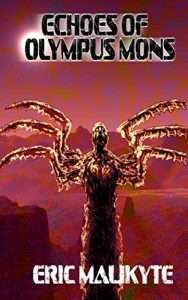 Eric Malikyte was also a name I was interested as well due to the fact I was a big fan of his book, Ego Trip. Indie cyberpunk is another one of my interests and I felt that it managed to capture both the modern zeitgeist as well as that aggressive rebelliousness so many other stories in the genre didn’t. So, I decided to give Echos of Olympos Mons a chance.
Eric Malikyte was also a name I was interested as well due to the fact I was a big fan of his book, Ego Trip. Indie cyberpunk is another one of my interests and I felt that it managed to capture both the modern zeitgeist as well as that aggressive rebelliousness so many other stories in the genre didn’t. So, I decided to give Echos of Olympos Mons a chance.
The premise is that humanity has colonized Mars and society is continuing on much the same way as it always has. Individuals go there to study due to the offered incentives for education and colonization. For Hal Leon, it was a chance to escape his religiously abusive father as well as the general poverty of Earth.
Unfortunately, Hal suffers from terminal arrogance and constantly butts heads with his professors as well as forwards wild theories like the non-localization of consciousness. Hal isn’t a religious person, quite the opposite, but carries a lot of ideals influenced by his background. Indeed, his desire to prove “his” theories is driven by a need to disprove his father’s beliefs. It reminds me a bit of Prometheus in reverse where Doctor Elizabeth Shaw wanted to prove God’s existence via the discovery of the Engineers.
Well, like a modern-day Frankenstein, Hal attempts his experiments on his own with the help of his associate, Akio Sato. Hal doesn’t quite cue to Akio’s real reason for helping him and no sooner do they dig their academic graves then he successfully alienates the last person on two worlds who gives a darn about him. But his experiment works! He’s certainly found something living in the dark matter (which has been proven to exist at this point in-universe)! Unfortunately, his experiment has attracted the attention of whatever it is he’s discovered.
Mayhem ensues.
Much of this story will be familiar to readers and it’s actually the places where it zigs instead of zags that make it good. At one point, after the bodies start piling up, Hal attempts to go to the authorities and explain what is going on. Their reaction? They look at the evidence and immediately try and start formulating a plan to deal with the obviously real problem rather than continue to deny it like lemmings.
The real selling point of the story is the character development that Hal undergoes throughout the story. He doesn’t become a hero per se but the realization that he’s responsible for so much of this (however inadvertently) as well as the emotional abuse he’s heaped on his friends is an interesting arc for a protagonist. Hal’s not just a mad scientist, he’s someone who was caught up in his own business that he couldn’t appreciate how much other people were sacrificing for him.
In conclusion, this is a solid and entertaining horror novel with a pretty good ending. I slightly prefer the original cover art and feel like the new cover spoils the reveal a bit but there’s something to be said for advertising what you’re all about. I definitely recommend this as a
horror novel.
The post REVIEW: Echoes of Olympos Mons by Eric Malikyte appeared first on Grimdark Magazine.
REVIEW: Painted Devils by Margaret Owen
Margaret Owen’s Painted Devils reunites us with some of our favourite characters from last year’s Little Thieves. The story is once again centred around chaotic disaster con artist Vanja Schmidt, and junior prefect Emeric Conrad. While the first book was mostly a straight-forward retelling of the Goose Girl fairy tale with great characters, well-written demisexuality and a heck of a lot of moral greyness, this second instalment in the series takes things up a notch. Because in a world where gods are very real, what happens if you accidentally start a cult? And one demanding a human sacrifice at that?
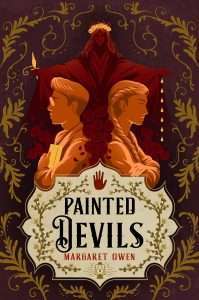 That’s exactly where Vanja finds herself in Painted Devils. Emeric has gone to take his final test to become a prefect, and she is due to follow him… Except she gets cold feet and ends up inventing a Scarlet Maiden to get help from villagers when she needs it – because it is Vanja’s nature to lie rather than admit she is in a pickle. And then, things start happening. The village prospers and Vanja finds a place as something of a prophet. Until Emeric shows up, that is. With a Prefect Emeritus in tow, he has been sent to investigate claims of a false god, only to be claimed as a virgin sacrifice by the manifested Scarlet Maiden on arrival. Oops. Vanja needs to figure a way out and fast.
That’s exactly where Vanja finds herself in Painted Devils. Emeric has gone to take his final test to become a prefect, and she is due to follow him… Except she gets cold feet and ends up inventing a Scarlet Maiden to get help from villagers when she needs it – because it is Vanja’s nature to lie rather than admit she is in a pickle. And then, things start happening. The village prospers and Vanja finds a place as something of a prophet. Until Emeric shows up, that is. With a Prefect Emeritus in tow, he has been sent to investigate claims of a false god, only to be claimed as a virgin sacrifice by the manifested Scarlet Maiden on arrival. Oops. Vanja needs to figure a way out and fast.
Painted Devils is in turn hilarious, touching and dark. The dark elements are definitely stronger in this second book than in the first, as the central themes and their stakes are bigger and more personal. We spend a lot of time learning about Vanja’s backstory, as she figures out what truly happened to her to make her the goddaughter of Death and Fortune, as she decides who she wants to be and who she wants to become. Another central theme is justice. What is justice, how does justice correlate to truth (both truth as in the objective truth and Truth as in the deity). In this, we have three core perspectives fighting each other throughout the story. Vanja, who is willing to do anything and everything for what she believes is the right and just thing, irrespective of laws or consequences – chaotic neutral if you will. Emeric, who has wanted nothing more than to become a prefect, but is starting to see that perhaps the law is very rigid if followed by the letter rather than the spirit, and believing in a sort of greater good mentality. And then there’s the Prefect Emeritus, following the letter of the law at all times and causing more harm than good. Justice becomes an interesting evaluation of morality, which makes Painted Devils an great light option for the Grimdark reader.
I also appreciated the theme of sacrifice. It is central to the story both on a literal and a metaphorical level, to the past and the present, the religious aspect and the tangible every day. It is one of the things that gives this series a lot of depth, despite its light writing style and sense of humour. As with Little Thieves, I devoured Painted Devils over the course of a day, cramming it into work breaks wherever possible. These books are compelling and have great narrative tension – and best of all, they are illustrated beautifully by the author. A winning package, once more.
Read Painted Devils by Margaret OwenThe post REVIEW: Painted Devils by Margaret Owen appeared first on Grimdark Magazine.
May 27, 2023
REVIEW: Tronick by Rosie Record
Tronick by Rosie Record is a cyberpunk novel that attracted me by its cover. They say you can’t judge a book by its cover but I feel like the Claire Redfield-esque biker girl picture is full of personality that drips out of the image. You can tell a lot about who Fiona Tronick is by this image and it inspired me to pick up the book. Was it worth it? Oh yes, definitely, though I would love to have a sequel in order to answer some of its mysteries.
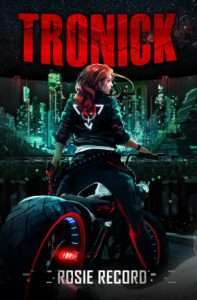 The premise is that California is isolated from the rest of the world by the massive wall that covers the entirety of the country. It apparently covers much of the ocean around it as well, calling into question whether or not this is a Matrix-like simulation or perhaps Dark City experiment. The people inside, generation PW 1.6 don’t know and don’t really care as they’re too wrapped up in their own problems.
The premise is that California is isolated from the rest of the world by the massive wall that covers the entirety of the country. It apparently covers much of the ocean around it as well, calling into question whether or not this is a Matrix-like simulation or perhaps Dark City experiment. The people inside, generation PW 1.6 don’t know and don’t really care as they’re too wrapped up in their own problems.
Fiona exists in the border between the street as well as the rich and powerful. While she pretends to be a low-level drug dealer, she’s actually an agent for the Agency. The Agency is a secret police that manages not only law enforcement in the California Annex but virtually everything else as well. Fiona thinks of herself as a rebel and one of the people but she’s involved in numerous projects to keep the crooked system functioning.
Ultimately, Tronick’s fence-sitting is unsustainable. As much as she likes to think she can walk the line and just hang out with the underworld as her friends, the simple fact is she is part of the system. A system that considers her friends to be enemies of the state and is using Tronick to get to them. The fact Tronick is blind to this fact is a bit unbelievable but the book shows she suffers from serious self-denial.
I really like the world-building of this book as we see the kind of hard scrabble existence that the California Annex’s citizens suffer through. Many of them are seeking something higher, whether religious or philosophical, but this just leads them to become vulnerable to scammers. The fact the Agency actively puts out bad faith operators to avoid losing even the slightest bit of control is a neat little detail.
Rosie Record’s prose is raw, dark, and full of intense emotions that are often absent from modern day cyberpunk stories as well as supposedly harder edged sci-fi. You get to taste the environment and what sort of world that our protagonists inhabit. The Annex’s inhabitants are surrounded by drugs, celebrity worship, crime, and an oppressive government. So, you know, nothing at all like modern day Los Angeles.
I think if you like dystopian science fiction but have aged out of The Hunger Games and Divergent readership, then you will like this. It’s definitely adult and mature but has a very likable protagonist even if she’s got some serious issues. I also think this is something that would appeal to fans of classic and more recent cyberpunk fair too.
Read Tronick by Rosie RecordThe post REVIEW: Tronick by Rosie Record appeared first on Grimdark Magazine.
May 25, 2023
REVIEW: Die By the Sword Edited by D.M. Ritzlin
DMR Books has quickly established itself as one of the premiere sources for new and reprinted fiction written in the pulp sword & sorcery and science fantasy traditions. They’ve released a number of anthologies in recent years, including the Swords of Steel series of dark fantasy stories written by heavy metal musicians and the horror-themed Samhain Sorceries. Rather than reprints or specially solicited authors, Die By the Sword is intended to be the first in a series of anthologies featuring all-new sword & sorcery tales gathered via open calls for submissions. This initial volume includes eleven stories by both previous DMR contributors (Howie K. Bentley, Matthew Knight, etc.) and newcomers. The gorgeous cover artwork is provided by underground comix and paperback veteran John Pound, who may be most well known among readers of a certain age for his work on Topps’ Garbage Pail Kids line of trading cards. Alas, the cover is a reissue of a painting from 1980 and no lion-headed warriors appear in this book.
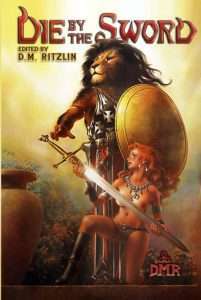 Die By the Sword starts off strong with “Ardax in Antillia” by Daniel R.A. Quiogue. Hailing from the Philippines, the prolific Quiogue has been popping up frequently in fantasy and adventure-fiction venues, including the first installment of Rakehell magazine and issue zero of New Edge Sword and Sorcery Magazine. As with those outings, Quiogue blends historically-inspired settings with swordplay and monsters, creating stories that bring to mind the classic Ray Harryhausen fantasy adventure movies. “Ardax in Antillia” involves a pair of gladiators who, after their escape from a Roman arena in Iberia, encounter a beautiful maiden condemned to be sacrificed to the cruel Atlantean gods. The fast-paced tale that follows is packed with visceral combat and fun aquatic monsters.
Die By the Sword starts off strong with “Ardax in Antillia” by Daniel R.A. Quiogue. Hailing from the Philippines, the prolific Quiogue has been popping up frequently in fantasy and adventure-fiction venues, including the first installment of Rakehell magazine and issue zero of New Edge Sword and Sorcery Magazine. As with those outings, Quiogue blends historically-inspired settings with swordplay and monsters, creating stories that bring to mind the classic Ray Harryhausen fantasy adventure movies. “Ardax in Antillia” involves a pair of gladiators who, after their escape from a Roman arena in Iberia, encounter a beautiful maiden condemned to be sacrificed to the cruel Atlantean gods. The fast-paced tale that follows is packed with visceral combat and fun aquatic monsters.
“Rites of the Black Goddess” by Paul D. Batteiger is another outstanding story. Fresh from the Crusades and Jerusalem, war-weary lord Morcar returns home to find his domain usurped by an arrogant Norman count. Through the aid of steel and decidedly unchristian magic, Morcar immediately sets about regaining his birthright. While most of the stories in Die By the Sword pair gritty combat with a dark outlook, this violent and moody piece is especially likely to appeal to grimdark fans.
Sharing a setting with the author’s 2022 novel Frolic on the Amaranthyn, Chase A. Folmar’s “The Sorcerer’s Scion” is another tale that emphasizes shadowy atmospherics. The bulk of this short chronicles the final hours of sell-sword Kulvrak—found killed under mysterious circumstances at the story’s outset—hired to rescue the daughter of a deranged herbalist from a nightmarish garden in squalid Old Iskalruun. Folmar cites classic Weird Tales scribe Clark Ashton Smith as an influence, and this story similarly delivers both lush prose and tense strangeness.
Inevitably with anthologies, some stories are less successful than others. Neither Howie K. Bentley’s “Secrets Only Dragons Know” nor “The Key to the Blood Pyramid” by Matthew Knight quite worked for me. The former involves Eldol, a warrior Briton who joins forces with a tribal witch in a quest for revenge against treacherous Saxons. The witch is demonstrated to have an agenda of her own, but muddy storytelling and an overly cryptic ending ensured that the titular dragons kept their secrets to themselves. “The Key to the Blood Pyramid” holds together better as a narrative, but the over-the-top vampyre-slaying magical armor-clad dimension-crossing protagonist (previously seen in 2019’s Karnov: Phantom-Clad Rider of the Cosmic Ice, by Knight, Bentley, and Byron A. Roberts) reminded this reviewer of a well-meaning but over-exuberant guy at a game store telling everyone within earshot all about his “cool” high-level Dungeons & Dragons character.
Among many strong stories, the highlight of Die By the Sword for me was Gregory D. Mele’s “The Heart of Vengeance.” Like Mele’s previous contributions to Tales From the Magician’s Skull No. 6 and Whetstone: Amateur Magazine of Pulp Sword and Sorcery issue 5, “The Heart of Vengeance” takes place in the Aztec-inspired setting of Azatlan. After warrior lord Helomon Twelve-Vulture loses his kingdom to a treacherous cousin, he embarks on an epic quest of retribution. He gains the mystical assistance of the skull-faced priesthood of Xokolatl, Lord Death, but is left with a troubling prophecy: all other victories will be Helomon’s, but should he seek the life of his usurper cousin he will not live to see the completion of his revenge. This central tension—is revenge worth one’s own death?—plus the intriguing setting combine for a very compelling dark fantasy tale.
Also worthy of note is the final story in Die By the Sword, “The Sacrifice” by Elias Varsity. Deceived by an alluring woman of the night, arrogant Greek wanderer Cleofas finds himself pinioned by a marble statue in an isolated ruin. His arm trapped in an unyielding stone fist, the harsh Mediterranean sun threatens to drive him delirious before an ignominious death of thirst. His only possible salvation lies with a cloaked, misshapen lurker that speaks in riddles. The shrouded figure offers him escape, but at a terrible price. A nasty little grimdark fable that deals quite directly with hubris and the punishment thereof, “The Sacrifice” lingers in the brain.
Die By the Sword is a strong collection of stories from fascinating newer voices. While not every story hit the mark with me, it is important to emphasize that NONE of the stories in Die By the Sword are boring. Violent action and fast-paced storytelling are ubiquitous, there is a generous serving of horror, and the stories are peppered with crowd-pleasing operatic themes like self-destructive revenge, desperate rescue missions, and rulers in exile. In addition to its reprints, DMR Books has devoted a great deal of effort to showcasing newer pulp sword & sorcery and dark fantasy authors. It’s exciting to see DMR casting its net even wider with open calls for submissions, and it is this reviewer’s hope that the proposed series continues.
Read Die By the Sword Edited by D.M. RitzlinThe post REVIEW: Die By the Sword Edited by D.M. Ritzlin appeared first on Grimdark Magazine.
May 24, 2023
REVIEW: Wartales
Wartales is a gritty, turn-based RPG developed and published by Shiro Games. Originally launching in Early Access, it became a full release in April of this year.
I’m a gigantic sucker for tactical sims, war games, and sandbox games, so when Wartales first launched in 2021, I clicked the buy button so fast, my laptop cried. So did my bank account. Not that I think Wartales is overpriced or anything like that. For the 29.99/35EUR/40USD, players can experience a solid, well-designed game that offers plenty of bells and whistles. While the game isn’t perfect (because what game is?) with slight tedium regarding late-game combat, the breathing open world, solid writing, and myriad of options make Wartales an easy recommendation.
Wartales takes place in a dark, somewhat broken fantasy world of Medieval culture, a land torn by strife, and where cutthroat mercenaries are king. In this tactical, sandbox RPG, the player is tasked with forming their own mercenary company. It reminds me a lot of Mount and Blade Warband — one of my favourite sandbox games in living memory. Instead of real-time battles, Wartales employs turn-based combat, with characters utilizing a wide range of abilities to slay enemies. Another game like Wartales is the excellent Battle Brothers, a hardcore mercenary company RPG.
GameplayThe game begins with several customization options, difficulty settings, and the like — player choice is important! There’s also the option to pick between free exploration and region-locked exploration. In the latter, the world grows more dangerous the further away from home you are, while free exploration mode sees the world level up as the player advances.

In the overworld map, the player takes their mercenary company through the world, making camp, forging a reputation for themselves, and carrying out contracts. There’s no underlying narrative in Wartales — this is all about forging your destiny. Because there’s no overarching story, this can be a detriment. As much as I love sandboxes to make my own, I’ve found my gaming tastes have changed in recent times. I prefer having a story to follow. Not that this move by Shiro Games is bad: far from it! This is a highly enjoyable game. I just wish some larger questlines mattered more. There are plenty of bounties to fulfill and multiple side quests, some well-written, but I know many gamers prefer having a story to follow. They provide an anchor to keep playing.
There’s plenty to do while managing your mercenary company. Characters can take on several professions, such as fishing, woodcutting, crafting, cooking, and petty thievery. With the unlock system for many bonuses and additional crafting options, there’s a wide range of ways players can roleplay. On the campaign map, there are resources to scavenge, dozens of locations to explore, and little events pop up to keep your journey interesting. The company requires food and payment frequently — starving and broke mercenaries make pissed-off folks, so managing income and supplies is important. This mechanic is fairly easy to manage on easy mode, while more challenging on higher difficulties. With so many ways to get money and food, I’ve played harder survival management games. It is just enough to keep players on their toes.
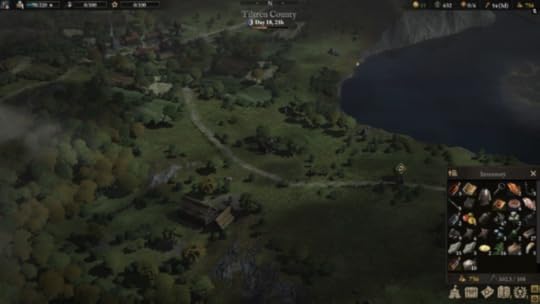
Characters can be a mix of different combat classes. There are the usual gubbins — rangers with powerful archery attacks, thieves who can launch ambushes and sneak attacks, and barbarian warriors with heavy armor. While the game offers a lot of freedom in how to spec characters, you can’t just equip anything to these. A ranger for instance isn’t going to wear that giant suit of plate mail armour! Combat is turn-based, and while your party size starts small, that rapidly changes as you pick up recruits. I have nine people in my company, not including pack animals. And yes, you can get your pack animals to fight too!
Wartale’s battles can get big. Even with my relatively small party, fights can take a while. Especially when enemy parties start building up, and they will outnumber you often. In late games, battles can go on for a while, and in a game where combat is often, this can get tedious. I hope in future patches, Shiro Games can balance this out, or at least give more options to speed up combat.
Overview and ConclusionWhile Wartales isn’t perfect, I’ve enjoyed playing it. This is a chunky and well-designed RPG, with plenty to enjoy. The medieval setting and the open-world survival mechanics make exploration a high point of the game. Managing my little company on their quest for whatever they want to achieve is incredibly absorbing. No story? Create your own! This is the true strength of Wartales. I take my party to towns to stock up on supplies and carry out missions, while working out where to go next. Do I have enough food to last me? My team of mercenaries needs paying at some point. Have I got enough resources and medicine to get my company through the attrition of war? My company has little conversations while camping for the night, and these small events keep the journey spicy. This is a game where the journey matters most — not the destination.

With full co-op support, Wartales offers an equally engrossing experience for both solo parties and friends, a rarity in this genre. I’m hoping for mod support in the future. In conclusion, Wartales is one of those success stories of Early Access. We often hear about disasters, but there are so many great games out there that I focus on the positive sides of life. With its dynamic open world, great management mechanics, and solid performance across the board, I recommend it for any strategy game fan.
Final score: 4/5.
The post REVIEW: Wartales appeared first on Grimdark Magazine.
May 23, 2023
REVIEW: Witch King by Martha Wells
Witch King is the new standalone dark fantasy from acclaimed Murderbot author Martha Wells. Witch King marks her much-anticipated return to fantasy after completing her Books of the Raksura series.
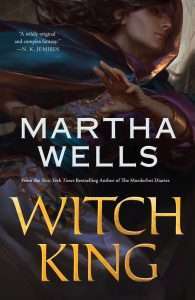 Kai, the eponymous Witch King, is a powerful demon with a necromancy-type magic enabling him to occupy the bodies of deceased mortals. As the novel opens, Kai slowly regains consciousness to find that his mortal body has been murdered and his spirit is imprisoned in some sort of water cage:
Kai, the eponymous Witch King, is a powerful demon with a necromancy-type magic enabling him to occupy the bodies of deceased mortals. As the novel opens, Kai slowly regains consciousness to find that his mortal body has been murdered and his spirit is imprisoned in some sort of water cage:
“Waking was floating to the surface of a soft world of water, not what Kai had expected. Reaching out in that darkness, he found a cold, black sea ebbing and flowing, dropping away like a tide rolling out. Something was wrong with his body, everything was impossibly distant.”
Witch King alternates between two timelines. In the present day, Kai tries to piece together the puzzle of who betrayed him. The present-day timeline is interspersed with chapters from the past, showing a more powerful Kai imposing his will on the world. Clues from the past timeline help to inform the reader about the present-day narrative.
Kai is a fascinating character who exhibits a wry sense of humor, making Witch King fun to read in places, such as in the following exchange:
“I didn’t know you were a…demon.”
“You idiot. I’m the demon.”
Despite these humorous moments, most of Witch King is a dry read that fails to establish much meaningful connection to the world or characters. Although Kai exhibits sparks of charisma, the other characters mostly fall flat.
Martha Wells’s writing is solid, but Witch King suffers from slow pacing and a dense, disengaging style that makes the book a struggle to read. As a result, I never felt fully invested in the story or characters.
There are hints of great worldbuilding in Witch King, but unfortunately it is never fully developed in a satisfying way. Martha Wells drops the reader into the world at the beginning of the story, but her approach generates more questions than answers. Overall, the worldbuilding feels surprisingly shallow, and Witch King proves to be an unnecessarily challenging read where the payoff is not commensurate with the effort involved.
Despite its intriguing premise and flashes of sardonic humor, Witch King fails to deliver a story with enough depth or emotional connection for me to care as a reader. Grimdark readers may want to skip this one and read some of the author’s back catalog instead.
2/5
Read Witch King by Martha WellsThe post REVIEW: Witch King by Martha Wells appeared first on Grimdark Magazine.
May 22, 2023
REVIEW: The Keeper’s Six by Kate Elliott
Combine power-hungry dragons and realm-travelling magic with a contemporary fantasy setting and you get something like Kate Elliott’s novella The Keeper’s Six, which sees wearily determined mum Esther breaking the rules and getting her adventuring party back together to rescue her kidnapped son, Daniel. Despite being banned from travelling the Beyond (the space between worlds) by the bureaucracy of the Concilium, Esther’s Hex–a six-strong group each with their own unique set of skills, aptitudes and magics–quickly regroup in the wake of Daniel’s disappearance, setting out to find whoever’s responsible for his kidnapping and bring him back. Given that Esther was to blame for their licence being revoked though, there are some lingering tensions still unresolved between them.
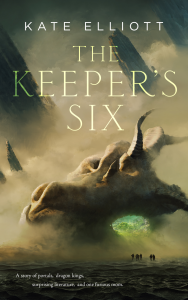 As they brave the dangers of the Beyond, Esther and her companions find themselves dealing with everything from conniving dragon bosses to byzantine bureaucracy, largely (but not entirely) eschewing anything too physical in favour of subterfuge, speed, hard-nosed negotiations and, surprisingly, the introduction of worker rights to dragons’ minions. It’s a fairly straightforward quest plot on the surface, but Elliott focuses less on fighting and more on Esther’s internal struggle and the dynamic within the Hex, adding depth to the characters and exploring themes of acceptance and forgiveness, family bonds (both flesh and blood, and found family) and a mother’s determination to do whatever it takes to protect the people she loves. As such, this is in fact anything but your standard fantasy quest story.
As they brave the dangers of the Beyond, Esther and her companions find themselves dealing with everything from conniving dragon bosses to byzantine bureaucracy, largely (but not entirely) eschewing anything too physical in favour of subterfuge, speed, hard-nosed negotiations and, surprisingly, the introduction of worker rights to dragons’ minions. It’s a fairly straightforward quest plot on the surface, but Elliott focuses less on fighting and more on Esther’s internal struggle and the dynamic within the Hex, adding depth to the characters and exploring themes of acceptance and forgiveness, family bonds (both flesh and blood, and found family) and a mother’s determination to do whatever it takes to protect the people she loves. As such, this is in fact anything but your standard fantasy quest story.
It’s not necessarily grimdark, at least at a first glance–there’s a lot here that will appeal to readers looking for manipulative dragons, bickering adventuring parties and vividly-drawn fantasy settings, but while there are some dark moments the tone is generally more hopeful. Really it’s a subversion of a lot of the usual fantasy tropes, playing around with things like dragons being conniving gang bosses rather than noble sages, and the protagonist as an older, experienced mother. If you look past the surface details though, this does perhaps tap into that sense of realism (if that’s the right word) that grimdark at its best can focus in on, with a protagonist who’s very much not the glorious hero, and who has to work hard to get where she needs to go with no sense of destiny to help her along the way.
It also takes place in a genuinely amazing setting, which cleverly positions Earth as just a small, largely unimportant backwater in the context of all the worlds linked together by the Beyond and the magic of the Hexes. The magic system itself is largely focused on enabling people to navigate the Beyond and protect themselves (or at least try to) when they’re travelling, while the dragons are very much part of the bureaucratic system, contributing to a definite power imbalance and, on occasion, some of the funniest moments of the book. There’s a lot to fit into a short page count, in terms of both narrative and worldbuilding, and as such this definitely rewards readers willing to be patient and embrace the constraints of a novella, but it’s well worth the patience and understanding.
It’s hard not to wish this was longer, with more space to really explore its locations and ideas, but flip that on its head and you have a setting that’s ripe for further exploration and more adventures! As it stands though, while this definitely leaves the reader wanting more (which is a good thing, really) it does still deliver an impactful and brilliantly entertaining story, full of great characters and offering something a little different to your regular fantasy adventure. Highly recommended.
Read The Keeper’s Six by Kate ElliottThe post REVIEW: The Keeper’s Six by Kate Elliott appeared first on Grimdark Magazine.
May 21, 2023
REVIEW: Bonesmith by Nicki Pau Preto
Something that I remember very vividly about childhood is walking through forests. Looking at how pretty and otherworldly everything looked. The deeper I walked, the more I found things that looked ancient. Things shined in the right light and suddenly a perfectly simple branch looks like a bone. Either I watched too much Disney, or my mother read me too many horrific fairy tales, but I know this for sure. Nicki Pau Preto’s Bonesmith seems to have the right idea about making forests deadly.
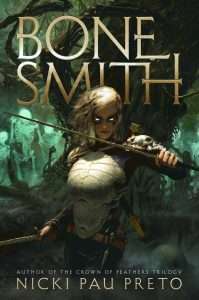 Nicki Pau Preto’s Young Adult novel, Bonesmith, takes that escapist fantasy imagination with pure enthusiasm.
Nicki Pau Preto’s Young Adult novel, Bonesmith, takes that escapist fantasy imagination with pure enthusiasm.
It’s about a teen girl, who we quickly learn wants to be worthy of her family. Wren wants to prove herself to her father but does not have the type of relationship with her family that you would describe as unconditional. Hoping to serve as a valkyr for the House of Bone, she hopes to live up to her family’s expectations. Told to protect Leopold, a House of Gold prince, Wren ends up in a conflicting situation between rescuing a kidnapped prince and dealing with an irascible exiled enemy. She and Julian, the aforesaid enemy, brave the haunted, ever-spooky Dominions in a reluctant alliance. They are both attacked and haunted by the dead (Wren is at the ready with a sword!). Up against one ghoulish thing after the next, they spend time talking about their people and their hurts, opening more nuanced revelations. Wren goes through life as a fan of the chaos approach: barging through a fight. That attitude goes against Julian’s more strategic approach to life. These are two young people in a world of adults plunging kids into the politics of their parents. They are just here to deal with the world given to them.
The author takes the reader to discover a very “word” enthusiastic exploration of people and their origins. The people in Bonesmith have smithing abilities, providing them with magical talents to spin or “smith” the world around them. Ironsmiths can magically craft with iron. Woodsmiths craft wood. Goldsmiths with gold. Bonesmiths, like Wren, can command bones and even ghosts. Bonesmith reminded me a lot of playing a video game. Warriors outfitted in bone armor walk a forest of bone, where skeletal creatures and necromancy haunt them. That feeling of smithing and metal feels very crucial to the gamer in me.
All the undead ghoulishness promises a story for teen and young adult audiences of The Locked Tomb. Throughout Bonesmith, we get a bit of the type of things fans will like or at least give a reminder of the comparisons sold on the back of the book. Bones are in every sleeve and pocket.
Bonesmith manages to delight in bones and hauntings. Although, I do have qualms about some parts of the novel feeling a little too heavy on descriptions without getting into the interesting bits of character work. Pick up Bonesmith to sate your thirst for bones, creepy forests, and twisty forests.
Read Bonesmith by Nicki Pau PretoThe post REVIEW: Bonesmith by Nicki Pau Preto appeared first on Grimdark Magazine.



